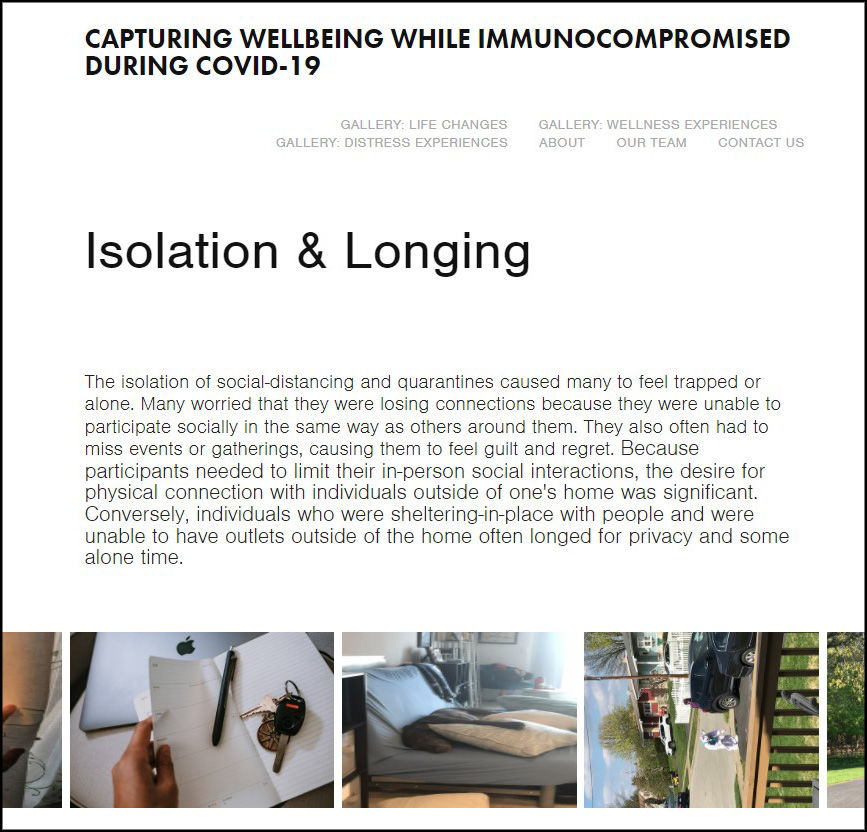What does it feel like to live in an immune-compromised body, in a world facing a global pandemic? A newly published study, led by nursing assistant professor Laura Sinko, offers a glimpse. In the spring of 2020, the start of the COVID-19 pandemic, Sinko and co-researchers solicited photos from people living across America with severely compromised immune systems.
“Photo elicitation is a research method that's underutilized, but it really lets you see the world through the eyes of someone else,” Sinko says. “That can be really powerful when we're trying to understand differences in human experience. Photography can evoke that feeling of empathy, that feeling of that mutual understanding.”
Sinko’s paper reporting on the photo elicitation project, co-authored with researchers from the University of Pennsylvania, Thomas Jefferson University and the University of Colorado, appears in the Journal of Community Psychology.

As part of a newly published study, Laura Sinko and co-researchers solicited photos from people living across America with severely compromised immune systems during the early days of COVID-19. The photos were shared in an online gallery (pictured).
The photo elicitation project, done in partnership with online support organizations for people with chronic illness, asked participants to submit photographs highlighting changes to their routines or living environments as well as their “emotional experience” and mental health during the early stages of the pandemic (April-June 2020). Participants also were given open-ended questions asking how they had been impacted by the pandemic and how the community support they experienced had changed.
The photo submissions, some of which are presented in the paper and on a portfolio web page, reflect many predictable and universal feelings such as isolation and safety fears. But other photos highlight aspects of immune-compromised life during COVID that the general public might not appreciate. One photo shows a wheelchair with a t-shirt on it that says “I wore masks long before COVID 19.” One participant shared a comment that “those of us who are sick enough do not leave on a regular basis…the world is not much different until we get outside of the home.”
"For folks who were concerned about infection risk before the COVID-19 pandemic, seeing society prioritize infection precautions, for example wearing masks, washing hands, and enhancing provision delivery services, actually improved some aspects of their quality of life,” Sinko says. “They normally had to navigate the world without any community support.”
Sinko works primarily in trauma recovery. She knew that while the pandemic impacted everybody, not all people were affected in the same way. “There’s the analogy that we're all in the same storm, but in different boats. That resonated with me,” she says. “I have a family member who's severely immune-compromised, and his fear of his life being ended by this pandemic was just so different than other family members.”
Sinko thinks a photo presentation like this can have a different kind of impact than a numbers-based quantitative study. Seeing what real people are struggling with might be a more effective way to get others to change their own behaviors.
“Sometimes I think people who aren't at high risk of infection-related complications don't think about the mental health of the immune-compromised person, who looks out the windows and sees people walking around maskless or witnesses anti-vaccine rhetoric online or on television. You see the photos, and you can feel that,” Sinko says. “That awareness potentially can lead to new consideration of policies to provide better supports for these people as we move forward, she says.
In the end, the shared photo portfolio page created for the study served multiple purposes. It was a way to disseminate the research professionally and potentially raise awareness of issues faced by immune-compromised people. It also built a shared space for these individuals to find community.
“One of the resounding things that we found in our research was that people just felt really alone,” Sinko says. “A lot of them didn't really have a rich support network of immune-compromised people. So they could go to this page, whether they were part of the study or not, and see how other people were going through it and feel less alone.”
